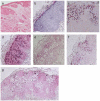Human papillomavirus gene expression in cutaneous squamous cell carcinomas from immunosuppressed and immunocompetent individuals
- PMID: 15982309
- PMCID: PMC3042681
- DOI: 10.1111/j.0022-202X.2005.23635.x
Human papillomavirus gene expression in cutaneous squamous cell carcinomas from immunosuppressed and immunocompetent individuals
Abstract
Epidermodysplasia verruciformis (EV)-type human papillomavirus (HPV) DNA have been detected by PCR in squamous cell carcinomas (SCC) from both organ transplant recipients (OTR) and immunocompetent individuals. Their role in skin cancer remains unclear, and previous studies have not addressed whether the viruses are transcriptionally active. We have used in situ hybridization to investigate the transcriptional activity and DNA localization of HPV. EV-HPV gene transcripts were demonstrated in four of 11 (36%) OTR SCC, one of two (50%) IC SCC, and one of five (20%) OTR warts positive by PCR. Viral DNA co-localized with E2/E4 early region gene transcripts in the middle or upper epidermal layers. Non-EV cutaneous HPV gene transcripts were demonstrated in one of five (20%) OTR SCC and four of 10 (40%) OTR warts. In mixed infections transcripts for both types were detected in two of six (33%) cases. Our results provide evidence of EV-HPV gene expression in SCC; although only a proportion of tumors were positive, the similarly low transcriptional activity in warts suggests this is an underestimate. These observations, together with emerging epidemiological and functional data, provide further reason to focus on the contribution of EV-HPV types to the pathogenesis of cutaneous SCC.
Figures







Comment in
-
Human papillomaviruses associated with epidermodysplasia verruciformis in non-melanoma skin cancers: guilty or innocent?J Invest Dermatol. 2005 Jul;125(1):xii-xiii. doi: 10.1111/j.0022-202X.2005.23811.x. J Invest Dermatol. 2005. PMID: 15982294 No abstract available.
Similar articles
-
Cutaneous squamous cell carcinoma and human papillomavirus: is there an association?Dermatol Surg. 2013 Jan;39(1 Pt 1):1-23. doi: 10.1111/j.1524-4725.2012.02558.x. Epub 2012 Aug 28. Dermatol Surg. 2013. PMID: 22928516 Free PMC article. Review.
-
Increased risk of skin cancer associated with the presence of epidermodysplasia verruciformis human papillomavirus types in normal skin.Br J Dermatol. 2004 May;150(5):949-57. doi: 10.1111/j.1365-2133.2004.05847.x. Br J Dermatol. 2004. PMID: 15149508
-
Case-control study in a subtropical Australian population to assess the relation between non-melanoma skin cancer and epidermodysplasia verruciformis human papillomavirus DNA in plucked eyebrow hairs. The Nambour Skin Cancer Prevention Study Group.Int J Cancer. 2000 Apr 1;86(1):118-21. doi: 10.1002/(sici)1097-0215(20000401)86:1<118::aid-ijc18>3.0.co;2-2. Int J Cancer. 2000. PMID: 10728604
-
Human papillomavirus infection and non-melanoma skin cancer in immunosuppressed and immunocompetent individuals.J Med Virol. 2000 Jul;61(3):289-97. doi: 10.1002/1096-9071(200007)61:3<289::aid-jmv2>3.0.co;2-z. J Med Virol. 2000. PMID: 10861635
-
Epidermodysplasia verruciformis.Curr Probl Dermatol. 2014;45:123-31. doi: 10.1159/000356068. Epub 2014 Mar 17. Curr Probl Dermatol. 2014. PMID: 24643182 Review.
Cited by
-
Detection of human papillomavirus DNA in cutaneous squamous cell carcinoma among immunocompetent individuals.J Invest Dermatol. 2008 Jun;128(6):1409-17. doi: 10.1038/sj.jid.5701227. Epub 2008 Jan 10. J Invest Dermatol. 2008. PMID: 18185530 Free PMC article.
-
Serological relationship between cutaneous human papillomavirus types 5, 8 and 92.J Gen Virol. 2009 Jan;90(Pt 1):136-43. doi: 10.1099/vir.0.006189-0. J Gen Virol. 2009. PMID: 19088282 Free PMC article.
-
Cutaneous squamous cell carcinoma and human papillomavirus: is there an association?Dermatol Surg. 2013 Jan;39(1 Pt 1):1-23. doi: 10.1111/j.1524-4725.2012.02558.x. Epub 2012 Aug 28. Dermatol Surg. 2013. PMID: 22928516 Free PMC article. Review.
-
Cutaneous HPV8 and MmuPV1 E6 Proteins Target the NOTCH and TGF-β Tumor Suppressors to Inhibit Differentiation and Sustain Keratinocyte Proliferation.PLoS Pathog. 2017 Jan 20;13(1):e1006171. doi: 10.1371/journal.ppat.1006171. eCollection 2017 Jan. PLoS Pathog. 2017. PMID: 28107544 Free PMC article.
-
Role of human papillomavirus in cutaneous squamous cell carcinoma: a meta-analysis.J Am Acad Dermatol. 2014 Apr;70(4):621-629. doi: 10.1016/j.jaad.2014.01.857. J Am Acad Dermatol. 2014. PMID: 24629358 Free PMC article.
References
-
- Bohm S, Wilczynski SP, Pfister H, Iftner T. The predominant mRNA class in HPV16-infected genital neoplasias does not encode the E6 or the E7 protein. Int J Cancer. 1993;55:791–798. - PubMed
-
- Bouwes Bavinck JN, Stark S, Petridis AK, et al. The presence of antibodies against virus-like particles of epidermodysplasia verruciformis-associated human papillomavirus type 8 in patients with actinic keratoses. Br J Dermatol. 2000;142:103–109. - PubMed
-
- Boxman IL, Berkhout RJ, Mulder LH, Wolkers MC, Bouwes Bavinck JN, Vermeer BJ, ter Schegget J. Detection of EV-HPV DNA in plucked hairs from renal transplant recipients and healthy volunteers. J Invest Dermatol. 1997;108:712–715. - PubMed
Publication types
MeSH terms
Substances
Grants and funding
LinkOut - more resources
Full Text Sources
Medical
Research Materials

